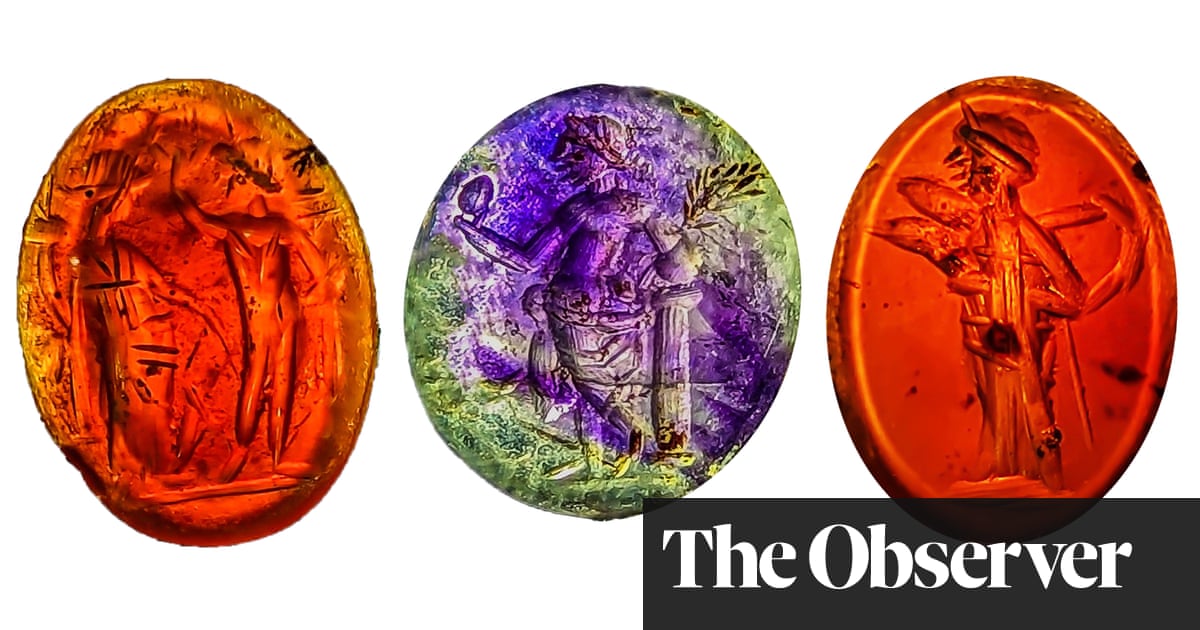
Taking your valuables with you into a swimming pool is always a risk. The Romans should have paid better heed, judging from the quantity of gemstones recovered from the drain of one of their bathhouses.
As many as 30 semi-precious stones have been discovered by archaeologists almost 2,000 years after their owners lost them at a site in modern-day Carlisle, just behind Hadrian’s Wall.
The stones had dropped out of their ring settings, their glue probably weakened in the steamy baths. They were simply flushed into the drains when the pools and saunas were cleaned.
Their loss would have been painful as these were engraved gems, known as intaglios. Although barely a few millimetres in diameter, they bear images whose extraordinary craftsmanship suggests they would have been expensive items in their day – the late 2nd century or 3rd century.
One bather lost an amethyst depicting Venus, holding either a flower or a mirror. Another lost a red-brown jasper featuring a satyr seated on rocks next to a sacred column.
Frank Giecco, an expert on Roman Britain who is leading the bathhouse excavation, was astonished by the collection: “It’s incredible,” he said. “It’s caught everyone’s imagination. They were just falling out of people’s rings who were using the baths. They were set with a vegetable glue and, in the hot and sweaty bathhouse, they fell out of the ring settings.”
He can imagine the Romans cursing after realising their loss. “They may not even have noticed until they got home because it’s the actual stone falling out of the rings – although we’ve also found one ring with a setting.”
Professor Martin Henig, an expert on Roman art at the University of Oxford, said: “Metal expands. If the stone is not properly secured, it can fall out, as it can today with people bathing. I imagine that the gems recovered from the drain were accumulated over time, and we must remember that a lot of people used those baths.”
Intaglios have previously been recovered from drains at York and at Caerleon near Newport. The Romans faced the dilemma we still face today of either losing their valuables in the water or to a sneak thief while they were bathing. This is reflected in several “curse tablets” found in Bath and elsewhere, which wished revenge on the perpetrators of such crimes.
One of those curses targets a ring thief: “So long as someone, whether slave or free, keeps silent or knows anything about it, he may be accursed in blood, and eyes and every limb and even have all intestines quite eaten away if he has stolen the ring.”
Henig said: “The difficulty is that you needed to take your ring off, but there were dangers. Where did you leave it? People must have been very upset when they lost a ring or the gem set in its bezel.”
The bathhouse was adjacent to the most important Roman fort on Hadrian’s Wall, the empire’s northern frontier, which held an elite cavalry unit and had links to the imperial court. Excavations will continue next year, but the evidence recovered so far – including imperial-stamped tiles – suggests that the bathhouse complex was monumental and opulent.
Giecco said: “You don’t find such gems on low-status Roman sites. So they’re not something that would have been worn by the poor.”
Beyond their decorative purposes, as rings worn by men and women, there was a symbolism within their imagery. The newly discovered intaglios include military themes, such as the god Mars holding a spear, and fertility, notably a charming image of a mouse nibbling a branch – Romans saw mice as symbols of rebirth or fertility.
Giecco said: “Some of the intaglios are minuscule, around 5mm ; 16mm is the largest intaglio. The craftsmanship to engrave such tiny things is incredible.”
The drain discoveries also include more than 40 women’s hairpins and 35 glass beads, probably from a necklace.












